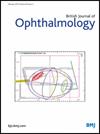Disease-specific and overall survival for patients with lacrimal gland adenoid cystic carcinoma in recent decades
IF 3.5
2区 医学
Q1 OPHTHALMOLOGY
引用次数: 0
Abstract
Purpose To evaluate the presenting symptoms, and the overall survival (OS) and disease-specific survival (DSS) in patients with lacrimal gland adenoid cystic carcinoma (LGACC). Methods This retrospective single-centre cohort study included all consecutive patients with LGACC treated by the primary author from November 1998 through August 2024. Demographic data, presenting symptoms, the histological subtype of LGACC, type of surgical treatment, adjuvant radiotherapy or chemotherapy, T category at presentation and survival data were reviewed. Correlations between histological subtypes, T-category, type of surgery (eye sparing vs orbital exenteration), and DSS and OS were analysed. Results 52 patients had a median age of 43.5 years (range: 9–71). Pain was the most common symptom but was only present in 17 patients (33%), 26 patients (50%) had orbital exenteration and 25 (48%) had eye-sparing surgery. Eye-sparing surgery was offered to selected patients only since 2007. Overall, 47 patients (90%) had postoperative radiotherapy and 18 patients (35%) developed distant metastasis. At last contact, 14 patients (27%) had died of disease (median follow-up=60 months). The 5-year and 10-year DSS rates for patients who had eye-sparing surgery (87.1% and 76.2%, respectively) were better than for patients who had orbital exenteration (62.3% and 57.5%, respectively, p=0.049). There was a significant difference between the DSS for basaloid (solid) versus non-basaloid histologic subtypes with a worse survival for basaloid histology (p=0.00057). Conclusions Pain was present in only one-third of patients with LGACC. The 5-year and 10-year DSS and OS rates are better than previously reported ‘historic data’. Data are available upon reasonable request.近几十年来泪腺腺样囊性癌患者的疾病特异性和总生存率
目的探讨泪腺腺样囊性癌(LGACC)患者的临床表现、总生存期(OS)和疾病特异性生存期(DSS)。方法本回顾性单中心队列研究纳入1998年11月至2024年8月期间由第一作者治疗的所有连续LGACC患者。回顾了人口统计学资料、表现症状、LGACC的组织学亚型、手术治疗类型、辅助放疗或化疗、就诊时的T分类和生存数据。分析组织学亚型、t型、手术类型(保眼vs眼眶摘除)、DSS和OS之间的相关性。结果52例患者中位年龄43.5岁(范围:9-71岁)。疼痛是最常见的症状,但仅在17例(33%)患者中出现,26例(50%)患者行眼窝剜除术,25例(48%)患者行保眼手术。自2007年以来,只向选定的患者提供保眼手术。总体而言,47例(90%)患者进行了术后放疗,18例(35%)患者发生远处转移。最后一次接触时,14例患者(27%)死于疾病(中位随访=60个月)。保眼手术患者的5年和10年DSS率(分别为87.1%和76.2%)优于眼眶剜除术患者(分别为62.3%和57.5%,p=0.049)。基底细胞样(固体)与非基底细胞样组织学亚型的DSS存在显著差异,基底细胞样组织学亚型的生存率较差(p=0.00057)。结论:只有三分之一的LGACC患者存在疼痛。5年和10年的DSS和OS率比之前报道的“历史数据”要好。如有合理要求,可提供资料。
本文章由计算机程序翻译,如有差异,请以英文原文为准。
求助全文
约1分钟内获得全文
求助全文
来源期刊
CiteScore
10.30
自引率
2.40%
发文量
213
审稿时长
3-6 weeks
期刊介绍:
The British Journal of Ophthalmology (BJO) is an international peer-reviewed journal for ophthalmologists and visual science specialists. BJO publishes clinical investigations, clinical observations, and clinically relevant laboratory investigations related to ophthalmology. It also provides major reviews and also publishes manuscripts covering regional issues in a global context.

 求助内容:
求助内容: 应助结果提醒方式:
应助结果提醒方式:


